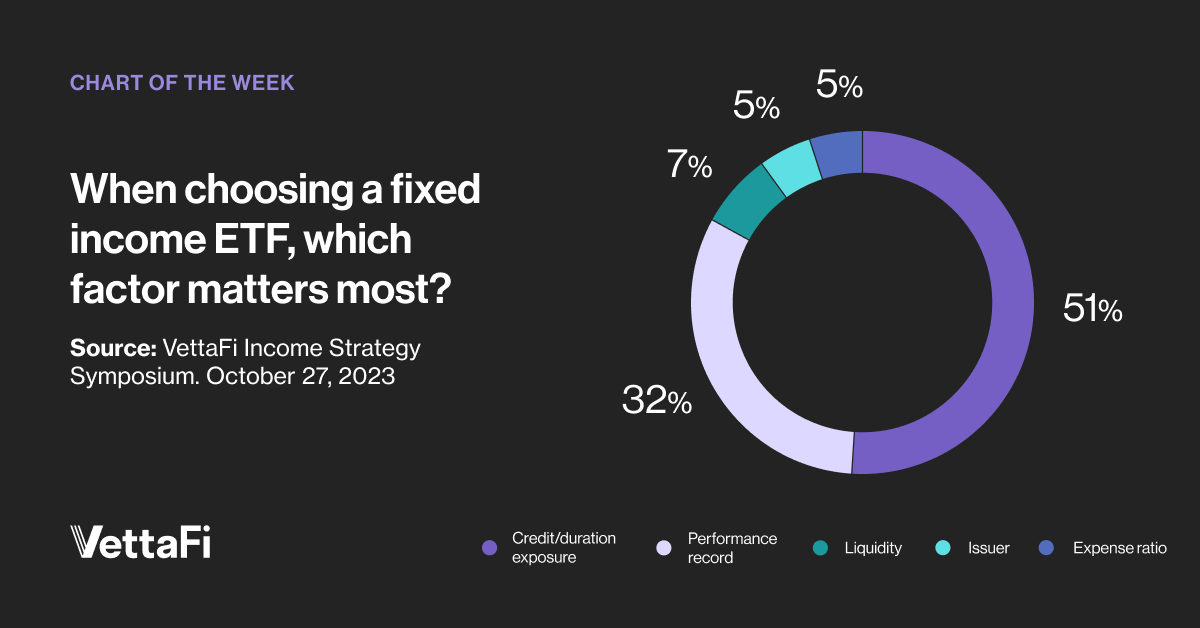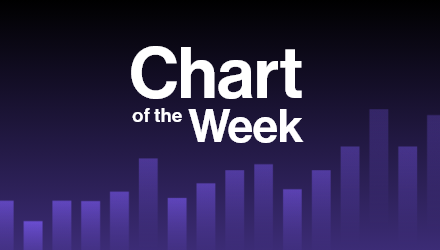In late October, VettaFi hosted an Income Strategy Symposium for hundreds of advisors and some end clients. We covered a range of topics with industry experts from Fidelity, T. Rowe Price, Vanguard, and others. For example, we talked about how to incorporate Fed policy into asset allocation decisions; whether or not taking on credit risk is warranted; and if active management is a better alternative for fixed income minded advisors. VettaFi also heard from the audience about what matters most to them.
We asked, “When choosing a fixed income ETF, which factor matters most?” Most respondents (51%) selected credit/duration exposure. Performance record (32%) and liquidity (7%) were also frequently chosen. Expense ratio and issuer were each approximately 5% of the responses. It was clear that the bonds inside mattered to many.

This is in stark contrast to the “Charles Schwab ETFs and Beyond Study” that was also released in October 2023. Schwab asked investors, “When choosing an ETF, how important is each of the following to you?” It offered a dozen choices and had people choose what was extremely important.
Total cost (58%) and low expense ratio (52%) were the highest (total cost includes trading costs). A smaller 45% selected access/exposure to a specific part of the market. Yet, how well it tracks an index, tax efficiency, and reputation of the ETF provider were among the options deemed more important to this base of investors.
Cost Is Not Driving ETF Flows
The Schwab study was not specific to fixed income. However, despite what the survey said, industrywide, people are not overwhelming choosing the cheapest U.S.-listed fixed income ETF around, even though it could make for a core position for many.
The BNY Mellon Core Bond ETF (BKAG) has $550 million in assets, despite a fee of 0.00%. If costs were truly one of the most important factors, the zero-fee BKAG would be rapidly climbing the assets leader board. BKAG tracks the widely followed Bloomberg US Aggregate Bond Index and owns investment-grade corporate and government bonds like Treasuries and agencies. The fund’s average duration was recently 6.0 years, and it sported a 30-day SEC yield of 5.0%. Despite all this, the ETF has pulled in just $160 million this year.
Exposure to Potential Rising or Falling Interest Rates Matters
The two most popular ETFs in October were notably different than BKAG. They are also extremely different from one another.
The SPDR Bloomberg 1-3 Month T-Bill ETF (BIL) gathered $6.0 billion last month. BIL has an average duration of 0.15 years and owns only U.S. Treasuries. The fund is among the most risk-averse ETFs around given its limited credit or interest rate risk. Yet after a series of Fed rate hikes, BIL has a 30-day SEC yield of 5.3% and rose 4.0% year to date through October. The exposure and the income are what has made BIL appealing to those wary that the Fed will keep rates higher for longer. What matters less is BIL’s 0.14% expense ratio.
See More: “Schwab Survey Reveals Strong Investor Preference for ETFs”
The iShares 20+Year Treasury Bond ETF (TLT) was also extremely popular in October. The long-term Treasury bond ETF gathered $2.9 billion, the second most for a fixed income offering. TLT has an average duration of over 16 years, making it almost three times more sensitive to bond yield movement as BKAG.
The fund has a 30-day SEC yield of 4.8%. While this is still appealing, money is flowing in from investors anticipating Fed rate cuts in 2024. If bond yields fall, TLT will be a beneficiary. However, in the first 10 months as rates rose, the ETF declined 14%. We think TLT’s net expense ratio of 0.15% is reasonable but is not what makes it popular.
For more news, information, and analysis, visit VettaFi | ETF Trends.
